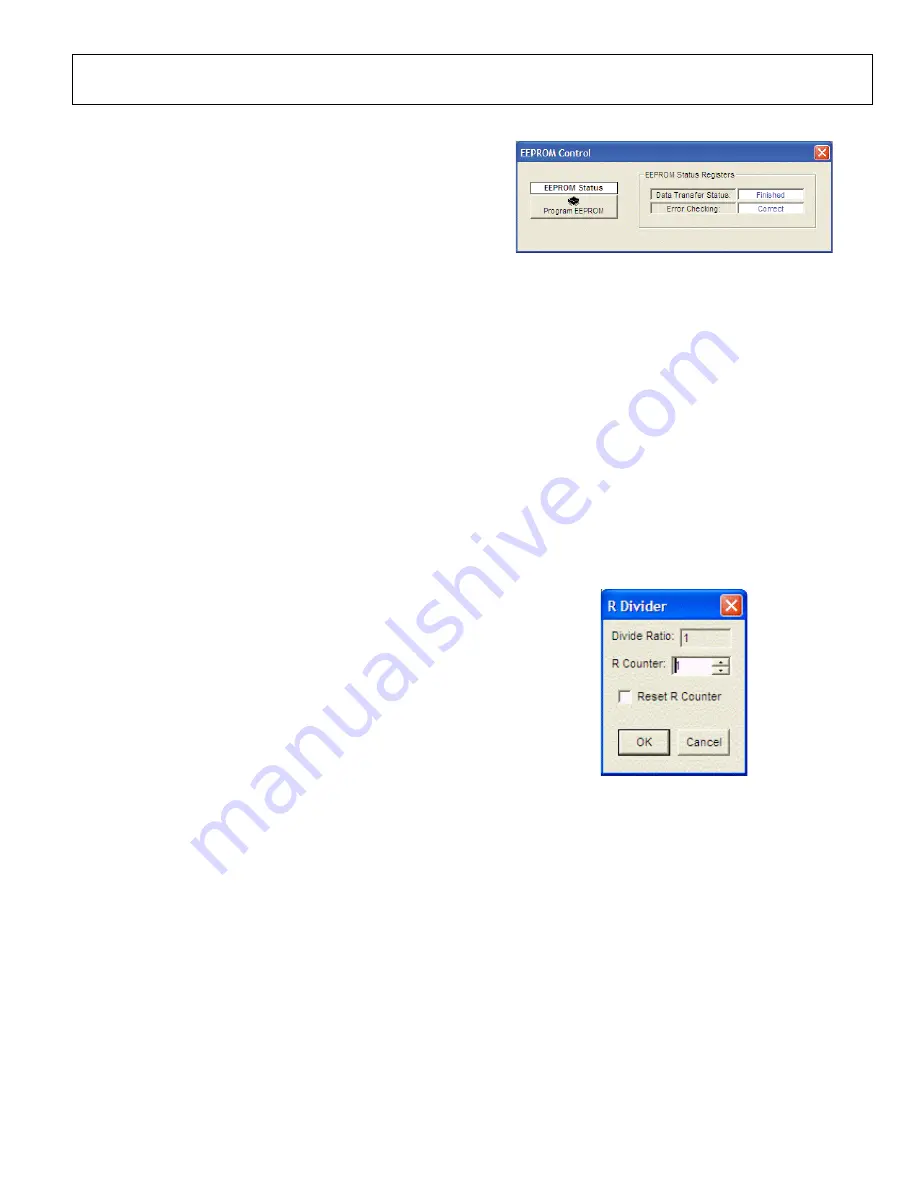
Evaluation Board User Guide
UG-077
Rev. 0 | Page 9 of 16
REFMON, STATUS, AND LD BUTTONS
These three blue buttons allow you to select which signals
appear at the REFMON, STATUS, and LD pins at Connector P1.
Connector P1 is located in the center of the evaluation board.
The pins in the left column of Connector P1 are ground pins,
and the ones in the right column are signal pins.
There are many useful diagnostic signals available at these pins.
The R divider output is particularly useful. In the example used
in the Quick Start Guide to the AD9522 PLL section, the 80 kHz
signal is visible on the STATUS pin to ensure that the reference
inputs and R divider are working properly.
Dynamic signals (such as the R divider output) are primarily
intended for diagnostics. These diagnostic signals may adversely
affect PLL performance in critical applications if left on in
normal operation.
REGISTER W/R BOX
The
REGISTER W/R
(write/read) box has three buttons and
three check boxes.
The
WRITE
button transfers the values stored in the evaluation
software to the evaluation board. It blinks red when register
values have changed.
The
READ
button transfers the values stored in the evaluation
board to the evaluation software.
The
UPDATE
button issues an I/O update command by writing
0x01 to Register 0x232.
Selecting the
All
check box transfers all of the registers when
the
WRITE
button is clicked. When this box is cleared, only the
registers whose value has changed are written.
Selecting the
Auto
check box adjacent to the
WRITE
box forces
the evaluation software to write the register changes to the
evaluation board automatically when they occur.
Selecting the
Auto
check box adjacent to the
UPDATE
box
forces the evaluation software to issue an I/O update command
whenever registers are written to the AD9522.
SYNC, PD (POWER DOWN), AND RESET BUTTONS
The
SYNC
,
PD
, and
RESET
buttons allow you to control these
pins on the AD9522.
Each button has three options:
Strobe
,
Latch
, and
Release
.
Strobe
activates the pin, and then releases it.
Latch
holds the
pin active until the
Release
command is issued.
EEPROM CONTROL WINDOW
08747-
011
Figure 12. AD9522 EEPROM Control Window
The EEPROM control window shown in Figure 12 is accessed
by clicking the
EEPROM
button near the lower left corner of
the main window.
To store the current register settings of the AD9522 to the
EEPROM, click the
Program EEPROM
button. Check the
EEPROM Status Registers
section on the right side of the
window to verify that the operation is successful.
To load the values stored in the EEPROM, ensure that the
EEPROM pin is pulled high and reset the AD9522.
The EEPROM pin is pulled high by placing the S4 EEPROM
jumper located in the lower left corner of the evaluation board
across the center and right (high) pin.
You can reset the AD9522 by clicking the red
RESET
button in the
low left corner of the main window, and selecting
Strobe ResetB
.
REFERENCE (R) DIVIDER WINDOW
08747-
012
Figure 13. AD9522 Reference Divider Window
The R divider window shown in Figure 13 is accessed by
clicking the
R DIVIDER
box. It allows you to set the reference
divider. If this box is colored gray, the PLL is off. To turn the
PLL on, click the
PLL MODE
box at the top of the main
window, and select
Norm Op
.
The
R Divider
window has a check box for holding the R
divider in reset. When the R divider is held in reset, the PLL
loop is opened. Therefore, this feature is seldom used.
The reference input path also has a reference multiply-by-2
X2
box that controls the reference clock doubler. This fre-
quency doubler can be used to double the phase detector
frequency of the PLL, and is described in detail in the AD9522
data sheet.
















